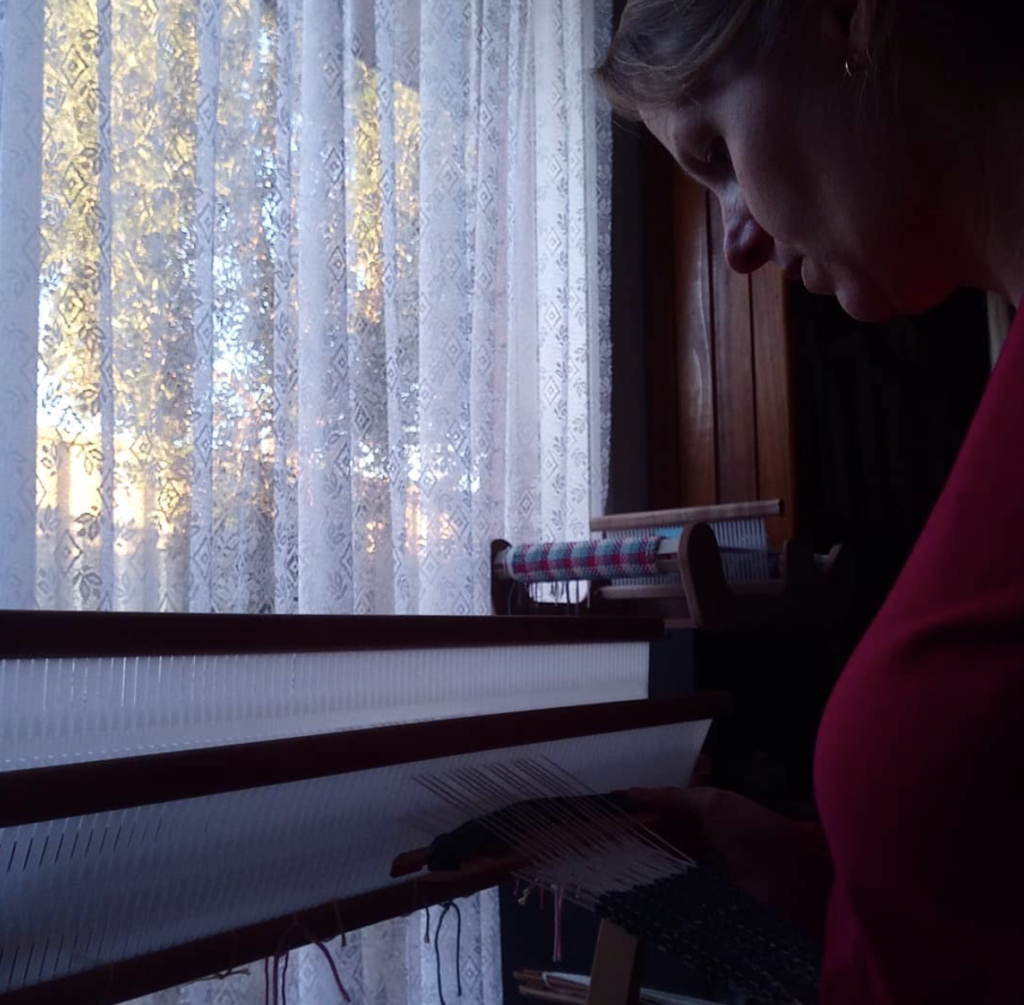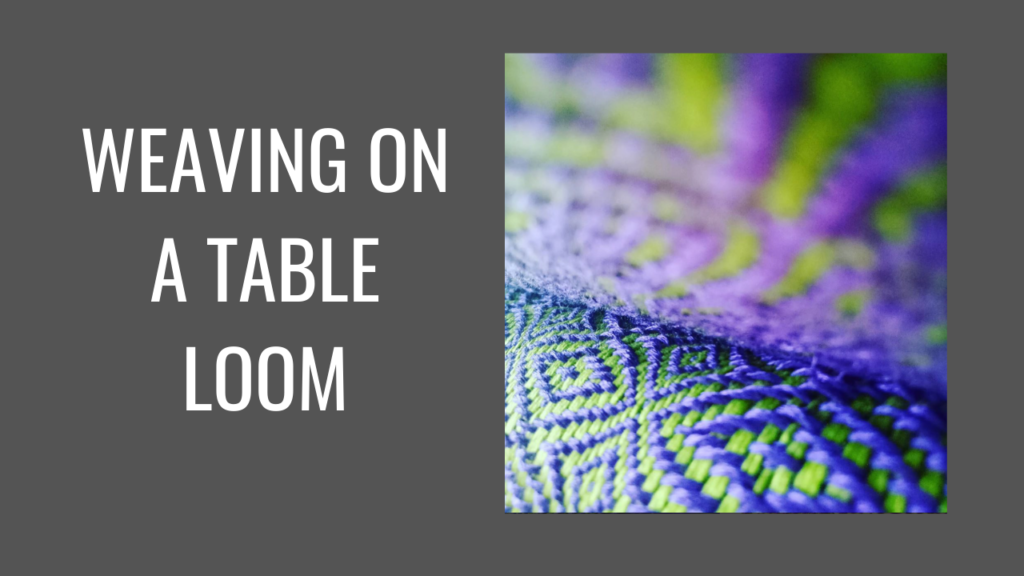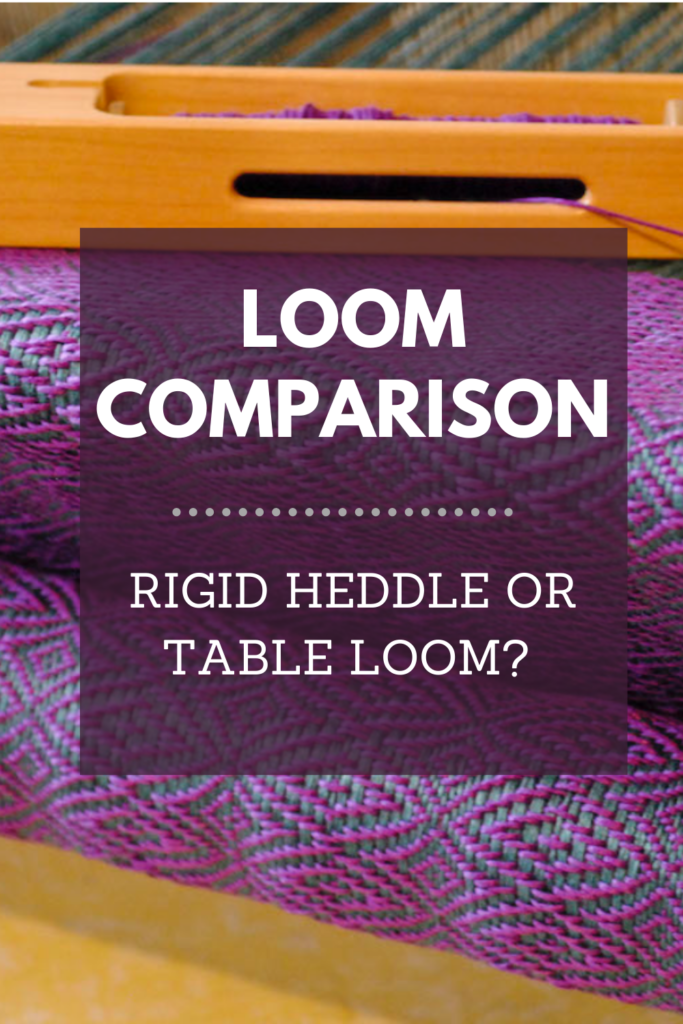When you’re starting out on your weaving journey, it can be confusing when you are faced with the variety of looms for purchase. How do you know before buying which one is going to suit your needs the best?
I get asked this question a lot, so I’ve put together a list of things to consider before purchasing. Specifically, I will compare the rigid heddle and the table loom, as these are the most common “beginner” looms available.
*This post contains affiliate links.
My first recommendation when considering the type of loom you might want to purchase is to try actually weaving on one. I know it’s not always possible, but if you have a friend who has a loom or you can get in touch with a guild that has looms for you to try, it can be a big bonus. Many shops that sell looms will be more than happy for you to come in store so that you can physically see and try a loom before buying too.
When I was looking for my first loom, a few factors contributed to my final decision.
- The price
- Simplicity of the loom
- Recommendations
My first loom purchase was the Ashford 24″ rigid heddle loom. I found that I could buy the loom and stand for a fraction of the price of a table loom. Having never woven anything in my life, I didn’t want to spend a heap of money up front, not knowing whether it was something I was definitely going to enjoy.
Being a complete newbie also helped me to decide on the RHL. I could see just by looking at it that it was a more simple loom, and I didn’t want something that was over complicated, as I was going to be weaving on my own.
I chatted with some craft friends online who already owned a rigid heddle loom, and their recommendations also helped me to decide that it was the right choice for me.
Now I’ll go over the pros and cons of the rigid heddle loom (in my opinion!):
Pros–
- It’s very lightweight and portable, making it easy to travel with or carry from room to room.
- Easy to learn. Like anything, becoming comfortable with a RHL takes time, but as long as you have good information, enthusiasm and practice, becoming a good weaver on a RHL is very achievable.
- Time efficient. I guess this comes under easy to learn as well, but the RHL is really quick and simple to warp and get weaving.
- Even though it’s a 2 shaft loom, it has more capabilities than meets the eye. By using pick up sticks, heddle rods and extra reeds, you can turn a RHL into a multi shaft loom. If this sounds interesting to you, I have an in depth class showing you how to convert 3 and 4 shaft pattern drafts to your RHL. You can find that class here. I also have a class that shows you how to achieve 4 shaft patterns by weaving with 3 heddles. You can find that class here.
- Very little loom waste (you gotta love that!)
- Very comfortable to sit at and use
- Affordable to get started
Cons–
- When I mentioned the possibilities in the “cons”, this means a little extra work and thought for the weaver. You may need some pretty good guidance to be able to set up your loom for more shafts or patterned weaving. A loom that is already set up for multi shafts is more efficient in this respect.
- Limited reed sizes. The smallest dent reed currently available is a 15 dent from Ashford. This is due to most reeds being manufactured with heavy duty plastic in a wooden frame. It can only go so small.
- It is hard to achieve good tension with finer yarns.
- I tend to use my rigid heddle loom with thicker yarns as I feel it is better suited. Is that a con? It’s not really, it’s more of a consideration!
Some weavers ask: “So why would you bother buying a table loom if you can do so much on a rigid heddle loom?”
Well, for me, I was keen to level up my weaving without the full investment of a floor loom. I admit that after weaving on a RHL for a few years, I had loom envy! I felt like everywhere I turned I saw wonderful 8 shaft patterns tempting me, and convincing me that I just had to be able to weave them! If you are completely content with your RHL, I admire you, I really do. I wish I was more like you! 😄
But seriously, I did want the challenge of learning to weave on a multi shaft loom. And I wanted to achieve intricate patterns on a loom that was built for that very purpose.
My first table loom was the Ashford 8 shaft, 32″.
So let’s look at some pros on cons of a table loom.
Pros–
- A more affordable way to set up for multi shaft weaving than a floor loom.
- All the shafts are there, once you have “dressed” the loom (warped, threaded, sleyed and tied on) you can just enjoy the weaving without further set up necessary.
- Boat shuttles work well.
- Castle is collapsable, so even though it stands somewhat tall it can be compacted down.
- Easy to use when it’s just sitting on a table.
Cons-
- You need a sturdy table to place it on
- Depending on the size of your loom, you may need help to move it.
- Some table loom weavers stand while weaving – that is not going to appeal to everyone (me included!)
- Not quite as comfortable to sit at as a RHL and it is best to have a good, height adjustable chair.
- Heddles are not moveable once your project is threaded. You can make extra heddles if you need to, but cannot move the shafts during a project.
- Dressing the loom is quite a time commitment!
- Shed can be small
- Depending on the size of the loom, you may not be able to advance the warp from a seated position.
It seems like there are quite a few cons for the table loom, but I try to give as much information as possible and don’t want to leave out any observations that I think are important.
I do think table looms are awesome, and for me, my table loom was a huge leap in my weaving knowledge and ability, especially towards my journey of owning and using a floor loom.
If you enjoyed this post, you may also want to watch the companion video:
If you want to learn more about table looms, please go to this post. Or, if you are interested in rigid heddle looms this post will help. Actually, I have a lot of rigid heddle posts here, so you can also use the search bar at the top of this page and type in “rigid heddle” and you will be spoiled for choice.
I hope this post was really useful to you, as always, you can speak to me in the comments or ask any burning questions you may have.
If learning to weave on a rigid heddle loom is interesting to you, my From Woe to Go! Beginner Rigid Heddle Weaving class is for you 😊
Or, if table loom weaving is your thing, my extensive Weaving on a Table Loom course is what you need.
I also have a comprehensive First Loom Buyers Guide that covers a range of looms to help you make an educated choice in purchasing.
Until next time…
Happy Weaving!






Oh my goodness, I have loom envy now after watching your video on table looms. I have 16″ RHL and want to upsize. Now you got me thinking table loom. 8 shaft, 16? 24″, 36″. I have limited space. Does the warping board on the 16″ big enough for the table loom?
Hi Marlene,
I have a separate, large warping board for my table and floor loom. I guess the question is, what length of warp can you achieve currently and is that long enough for what you would want to weave on a table loom?
I just found your site and love all the info you give. I plan to get your monthly class subscription. I am going to experiment and make a rigid heddle loom. My brother has a 3d printer and he can print heddles and some of the pieces of the loom for me. I would be using dowels for the wood parts to hold the 3d printed parts together. I am debating doing 24 or 32″ I want to make fabric and quilts/blankets as well as nice soft and fluffy towels. I could go as large as a 48 inch, but I don’t have space for that. I have a pretty small house so 32 is pushing it even. I don’t think a stand that is made for an ashford loom would work, so I would have to think of another way to deal with my loom. I do have an adjustable chair and a large table in my craft room so I was thinking of just adjusting my chair to be tall enough and treating it like a floor loom. I would love advice.
Hi Reelyn,
From what you’ve described about what you would most likely be weaving, I think you would do well with a 32″. I have a 24″, which is fine, you can do double width for blankets etc, but it’s still a limited width if you’re likely to be weaving a lot of larger items.
Regarding the stand, quite a few weavers do make their own custom sized to fit their loom. Do you have any woodworking skills/tools or know anyone who does?
I love your courses and would like to do more. Might you do one explaining how to use a RHL pattern on a 4 or 8 shaft table loom, please? If not, could you tell me where I might find instructions for doing this? Thankyou.
Dee
I’ve thought about doing that Delia, and have certainly had lots of requests for the same, but it’s a tricky thing because there are so many variables. Rigid heddle patterns are often written instructions rather than drafts.
Anyway, a good resource is Jane Patrick’s The Weaver’s Idea Book. In the pick up section she shows drafts plus written instructions, which is helpful for starting to get your head around taking a rigid heddle pattern to a multi shaft loom.
Kelly I have and old Schacht 24″ Loom. It only has an up lock and to hold it in the down pos, I have to stuff it under the up block. there is no nut. only to let the heddle set on the yarn. My question is we will be traveling in our 5th wheel and was looking at the flip loom. What do you think about the Schacht and the flip. A friend said if I buy a 15″ my finished work would be only around 13″ is this correct. Thank you for your help you classes are great. You have been so helpful.
Hi Connie, I’ve never owned a Schacht but a lot of weavers own and love them. There can be difficulties when it comes to double heddle weaving because the heddle positions are different on Schacht looms. There are workarounds, but I find my Ashford very straightforward for weaving with more than one heddle.
I have a cricket loom and enjoy it and just got the Ashford 32 inch four shaft loom, second hand. Hurry up with the table loom videos. I need lots of help…soon.
I’m trying to! 😄